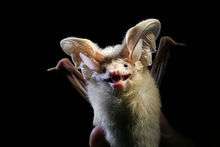Desert long-eared bat
| Desert long-eared bat | |
|---|---|
 | |
| Otonycteris hemprichii | |
| Scientific classification | |
| Kingdom: | Animalia |
| Phylum: | Chordata |
| Class: | Mammalia |
| Order: | Chiroptera |
| Family: | Vespertilionidae |
| Genus: | Otonycteris |
| Species: | O. hemprichii |
| Binomial name | |
| Otonycteris hemprichii Peters, 1859 | |
The desert long-eared bat (Otonycteris hemprichii) is a species of vesper bat found in North Africa and the Middle East.
Taxonomy
The systematic position of Otonycteris is unclear, but chromosomal analysis suggests close affinity to Barbastella and Plecotus[2]
Description
Head and body length is about 73–81 mm, tail length is about 47–70 mm, and forearm length is 57–67 mm. They weigh 18–20 g (0.63–0.71 oz).[3] The large ears, about 40 mm in length, are directed nearly horizontally and are connected across the forehead by a low band of skin. Five female specimens revealed two pairs of pectoral mammae, a unique condition in mammals. It is not known if both pairs are functional.
The coloration above is pale sandy to dark brown; the underparts are usually whitish. The skull and teeth of Otonycteris resemble those of Eptesicus. They even eat blood of other animal when they are dead.
Ecology and behavior
This bat occurs normally inhabiting extremely barren and arid regions.[4] Its habitat are xeric, sparsely vegetated and rocky. In the Negev Desert a pair was found roosting in a rocky crevice on a hill. This bat has also been found in buildings.
Otonycteris hemprichii has a "slow, floppy flight."[5]
Diet
Based on an analysis of its body mass, low aspect ratio, and low relative wing loading, the species is predicted to be carnivorous.[6] Observations in Kyrgyzstan indicate that the bat forages close to the ground, using echolocation to detect large flying or surface-dwelling invertebrates, and feeding mostly on arachnids and orthopterans that are seized directly from the ground.[7][8] A study in Israel found that up to 70% of the bat's dropping contain scorpion fragments, including the highly venomous Palestine yellow scorpion as well as other less venomous species. Laboratory observations indicate that the bats detect the scorpions by the noises they make as they walk. Once caught the bats bite the heads of the scorpion and frequently get stuck in the face by the scorpion's sting. When this occurs, no signs of toxicity have been recorded, suggesting that the bats are immune to the scorpion venom.[9][10] Despite this, they will contort in pain after sustaining repeated successful strikes from the scorpions.
Courtship and breeding
Breeding colonies of 3-15 females have been found, and seven pregnant females, most with two embryos, have been collected in central Asia.[8][11] Three pregnant females, each with two embryos, were found in a deserted hut in Jordan.[12]
Distribution and range
When the desert long-eared bat included the species now recognized as the Turkestani long-eared bat, its range included Morocco, northern Niger, Egypt, the Arabian peninsula, Kazakhstan, Kyrgyzstan, Pakistan, and northwest India.[13][14][15][8][11][16] However, when the recognition of the Turkestani long-eared bat split the genus Otonycteris into two species, the range of the desert long-eared bat was reevaluated. Its range is now recognized to include Afghanistan; Algeria; Egypt; India; Iran, Islamic Republic of; Israel; Jordan; Kazakhstan; Libya; Morocco; Niger; Oman; Pakistan; Qatar; Saudi Arabia; Sudan; Syrian Arab Republic; Tajikistan; Tunisia; Turkey; Turkmenistan; United Arab Emirates; and Uzbekistan.[1]
References
- 1 2 Monadjem, A.; Aulagnier, S.; Hutson, A.M.; Benda, P. (2017). "Otonycteris hemprichii". The IUCN Red List of Threatened Species. 2017: e.T85294528A22118826. doi:10.2305/IUCN.UK.2017-2.RLTS.T85294528A22118826.en. Retrieved October 15, 2017.
- ↑ Qumsiyeh, M. B., & Bickham, J. W. (1993). Chromosomes and relationships of long-eared bats of the genera Plecotus and Otonycteris. Journal of Mammalogy, 74(2), 376-382.
- ↑ Gaisler, J., Madkour, G., & Pelikán, J. (1972). On the bats (Chiroptera) of Egypt. Academia.
- ↑ Harrison, D. L. (1964). The Mammals of Arabia: Insectivora. Chiroptera. Primates (Vol. 1). E. Benn.
- ↑ Nowak, R. M. (1994). Walker's bats of the world. JHU Press
- ↑ Norberg, U. M., & Fenton, M. B. (1988). Carnivorous bats?. Biological Journal of the Linnean Society, 33(4), 383-394.
- ↑ Arlettaz, R., Dändliker, G., Kasybekov, E., Pillet, J. M., Rybin, S., & Zima, J. (1995). Feeding habits of the long-eared desert bat, Otonycteris hemprichi (Chiroptera: Vespertilionidae). Journal of Mammalogy, 76(3), 873-876.
- 1 2 3 Horacek, I. (1991). Enigma of Otonycteris: ecology, relationship, classification. Myotis, 29, 17-30.
- ↑ Holderied, M.; Korine, C.; Moritz, T. (2010). "Hemprich's long-eared bat (Otonycteris hemprichii) as a predator of scorpions: Whispering echolocation, passive gleaning and prey selection". Journal of Comparative Physiology A. 197 (5): 425–433. doi:10.1007/s00359-010-0608-3.
- ↑ Michael Marshall (2010-12-01). "The hardest bat in the world". New Scientist. Archived from the original on 2011-06-22. Retrieved 2011-06-22.
- 1 2 Roberts, T. J., & Bernhard (principe d'Olanda.). (1977). The mammals of Pakistan. London: E. Benn.
- ↑ Atallah, S. I. 1977. Mammals of the eastern Mediterranean region: their ecology, systematics and zoogeographical relationships. Säugetierkundliche Mitteilungen 25:241-320.
- ↑ Aulagnier, S., & Mein, P. (1985). Note sur la présence d'Otonycterus hemprichi Peters, 1859 au Maroc. Mammalia, 49(4), 582-584.
- ↑ Corbet, G. B. (1978). The mammals of the Palaearctic region: a taxonomic review. British Museum (Natural History), 341.
- ↑ Fairon, J. (1980). Deux nouvelles especes de cheiropteres pour la faune du Massif de l'Air (Niger): Otonycteris Hemprichi Peters, 1859 et Pipistrellus Nanus (Peters, 1852). J. Goemaere.
- ↑ Shaimardanov, R. (1982). Otonycteris-hemprichi and Barbastella-leucomelas (Chiroptera) in Kazakhstan. Zoologichesky Zhurnal, 61(11), 1765-1765.
Sources
- Walker's Mammals of the World Sixth Edition pg. 453-454
